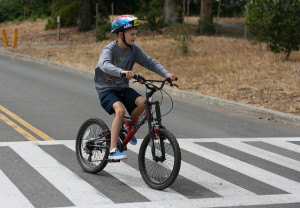For many children, cycling is a primary form of recreation and exercise. According to the Christensen & Hymas publication, “The Utah Bicycle Accident Handbook,” more than 70% of children ages 5 to 14 ride bicycles on a regular basis—accounting for more than 27 million children! Because children are such avid bike riders, they are also more prone to accidents and injury. Out of the total number of bicycle-related accidents, the 5 to 14 age bracket accounts for 24% of bicycle-related deaths and 50% of all bicycle injuries. Not only are children simply riding more than adult cyclists, but also they are more difficult to see and often do not always know all the necessary safety precautions. 
Parents can help teach their children basic bicycle safety. “The Utah Bicycle Accident Handbook” discusses many bicycle skills to learn and mistakes to avoid. Several of these skills are addressed below:
Skills to Learn
Before children can be fully ready to ride their bicycles unsupervised, they must first learn basic riding and safety skills. These skills include: riding in a straight line, turning, looking back without swerving, and braking control.
Riding in a straight line:
When children ride their bikes with friends and neighbors, they often have a large part of a neighborhood road or cul-de-sac to roam free with relaxed or no adult supervision. Because of this, many children do not learn to ride in a straight line. When teaching your child to ride, take them to a park or empty parking lot. Have them practice riding their bike on striped parking lines or narrow sidewalks to reinforce riding in a straight line.
Turning:
If your child is unfamiliar or uncomfortable with turning their bicycle, have them practice riding in a large figure eight pattern. Tighten the figure eight or create new, smaller formations as their turning skills improve.
Looking back without swerving:
Children must learn to look back over their shoulders while still riding in a straight line. When you are at a park or empty parking lot, have your child ride past you while looking forward. Then, either hold up a picture of a car or hide the picture behind your back. Instruct your child to look behind them to determine whether there is a car or not. Practice this exercise until your child can comfortably check over their shoulder for “traffic.”
Braking control:
Children often struggle with the concept of braking while on their bikes. Some children brake too quickly and lose control while others do not brake early enough and end up colliding with a person or object. To help your child learn to brake properly, draw a line on your driveway, sidewalk, or in an empty parking lot. Beginning at a slow speed and gradually working up to faster speeds, have your child ride up to the line and brake directly in front of it.
Parents who practice these basic cycling skills with their children can help reduce the chance of injury and greatly improve their kids’ confidence. Once young bicycle riders are trained to ride properly, they not only improve their own safety, but will improve the safety of everyone around them.
Photo Courtesy of Richard Masoner/Cyclelicious and Creative Commons.
